2000 Photo Gallery
The photographs presented here may be freely used for
any non-commercial purpose, but please credit the respective photographers. For
commercial use, please contact the photographers directly.
 |
Red-shanked Douc Langur (Pygathrix nemaeus) is a handsome, yet Endangered Asian colobine monkey found in south central Viet Nam and parts of neighbouring Laos. It is threatened throughout its limited range by habitat destruction and hunting, the latter both for food and for body parts, which are used to prepare traditional medicines. While a number of Douc Langur populations can still be found in parks and nature reserves, wildlife laws established to protect this and other threatened species are too often poorly enforced in the face of lucrative and illegal wildlife trade. Photo © Bill Konstant . |
 |
Mandrinette (Hibiscus fragilis) is one of the many Critically Endangered plant species unique to the island of Mauritius in the Indian Ocean. There are only 46 mature plants left at the two known localities and they are not regenerating because of competition from introduced alien plant species. Although the species is easy to propagate from cuttings, long-term maintenance in botanic gardens is problematic because the species hybridizes easily with the introduced garden plant Hibiscus rosa-sinensis. The only hope for the continued survival of the species is management of the wild populations, clearance of the alien invaders and restocking from known cultivated sources. Photo © Wendy Strahm . |
 |
Smalltooth Sawfish (Pristis pectinata) was uplisted to Critically Endangered in 2006. It is a widely distributed sawfish which has been wholly or nearly extirpated from large areas of its former range in the North Atlantic (Mediterranean, US Atlantic and Gulf of Mexico) and the Southwest Atlantic coast by fishing and habitat modification. Remaining populations are now small and fragmented distribution. It is apparently extinct in the Mediterranean and likely also the Northeast Atlantic. Reports of this species outside the Atlantic are now considered to have been misidentifications of other Pristis species. The individual shown here resides at Atlantis, Paradise Island in The Bahamas, site of the world's largest artificial marine habitat. Photo © Sun International Resorts, Inc . |
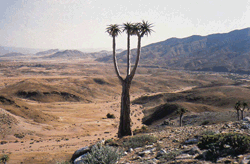 |
Bastard Quiver Tree (Aloe pillansii) is a Critically Endangered tree aloe occurring primarily in the mountainous Richtersveld area of the Northern Cape, South Africa and southern Namibia. A decline in the population has reduced the numbers to less than 200 mature individuals. No recruitment has been recorded at any of the main sub-populations probably due to the impacts of grazing by goats and donkeys and the older plants are dying. The species is sought after by collectors and owing to past depredations was listed on CITES Appendix I. The species is the focus of a major new survey and possible reintroduction programme by members of the IUCN/SSC Southern African Plant Specialist Group. Photo © Craig Hilton-Taylor . |
 |
Luschan's Salamander (Lyciasalamandra luschani) was uplisted to Endangered in 2004. The species ranges from southwestern Anatolia, Turkey, where it apparently has a fragmented distribtion. An endemic subspecies (L. l. basoglui) is found on the nearby Greek island of Kastellorizo. In Turkey, it is potentially threatened by habitat loss caused by forest fires and by overcollection for scientific purposes. Photo of the red phase form © Michael Franzen . |
 |
Asian Three-striped Box Turtle (Cuora trifasciata) is one of the most Critically Endangered freshwater turtles in Asia. Known to be native to southern China and northern Viet Nam, and almost certainly in Lao PDR and perhaps Myanmar, it is also arguably one of the most beautiful. The population has declined drastically because C. trifasciata is believed to have cancer-curing properties in traditional Chinese Medicine. In addition, it is a rare species that is highly sought by the pet trade. While the harvesting of many Asian turtle species for the food trade may slow once each species reaches a commercial extinction threshold, individual C. trifasciata will continue to be hunted even as individuals become harder to find because of the high perceived value of each turtle. The establishment of secure insurance colonies or heritage collections will probably be the only solution to prevent complete loss of C. trifasciata in the short-term. Photo of a captive animal © Kurt A. Buhlmann . |
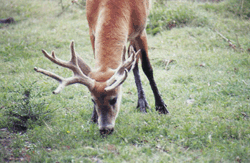 |
South American Marsh Deer (Blastocerus dichotomus) is the largest of the Neotropical deer occurring in seasonally wet marshes and inundated grasslands and forests of south central South America. The total population of marsh deer is currently unknown. However, ongoing decline is apparent in all areas as a result of poaching, cattle diseases, and habitat loss due to agricultural activities and dam constructions. In Uruguay the species is thought to be extinct: the last record from this country was in 1958. It is listed as Vulnerable. Photo © Mariano Gimenez Dixon . |
 |
The Wandering Albatross (Diomedea exulans) is listed as Vulnerable. All 21 species of albatross are now identified as globally under threat (compared to just three in 1996 and 16 in 2000). All are undergoing long-term declines, with significant numbers drowning after being caught accidentally on baited hooks set by longline fisheries. BirdLife International.s "Save the Albatross. campaign is trying to reduce the accidental bycatch of seabirds by encouraging longline fisheries to adopt appropriate mitigation measures. Photo © Tony Palliser . |
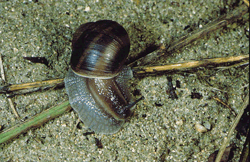 |
Corsican Snail (Helix ceratina), listed as Critically Endangered, was rediscovered in 1995 after having been last seen in 1902. There are only 7 hectares of habitat left, in the suburbs of Ajaccio, on the southwest coast of Corsica. The species is protected under French law, and its habitat is now covered by an "Arrêté de Protection de Biotope", the first ever taken specifically in France for a snail. Despite this, its survival near Ajaccio is in jeopardy because of development (airport, access to beach, etc.). Captive breeding has been successful and there are plans to establish a new population elsewhere in Corsica. In Neolithic times the Corsican Snail had a much wider distribution on the island. Photo © G. Falkner . |
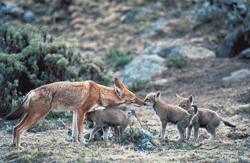 |
Ethiopian Wolf (Canis simensis), listed as Endangered, is confined to the highlands of Ethiopia in northeast Africa. It is estimated that there are less than 250 adults surviving. The species is less common and has a more reduced range now than in the past mostly because of habitat destruction through expanding agricultural activities. Human persecution triggered by political instability in the past is currently less severe and is associated to conflicts over livestock losses. Rabies is a potential threat to all populations. An Action Plan has been published which provides a detailed strategy for the conservation and management of the remaining populations. A number of important conservation measures have already been taken to protect this species, including vaccination of wolves affected by rabies, community education programmes, strengthening national park capacitiy within the species. range, and ongoing wolf population surveys and monitoring. Photo of a female Ethiopian Wolf greeting her cubs © Dada Gottelii . |
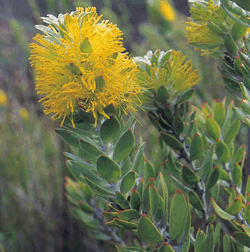 |
Golden Pagoda (Mimetes chrysanthus) is a Vulnerable member of the Proteaceae family. This magnificent species was only discovered as recently as 1987. Since that time, a number of small sub-populations have been found along the mountain ranges bordering the Little Karoo, Western Cape, South Africa. The main sub-population is in a nature reserve; however, frequent wild fires and invasive alien species pose a constant threat to this species. Plants are now in cultivation and the species is rapidly becoming popular in the horticultural trade. Careful management of the wild population is required through removal of alien invasive species and the prevention of frequent wild fires. Photo © Craig Hilton-Taylor . |










